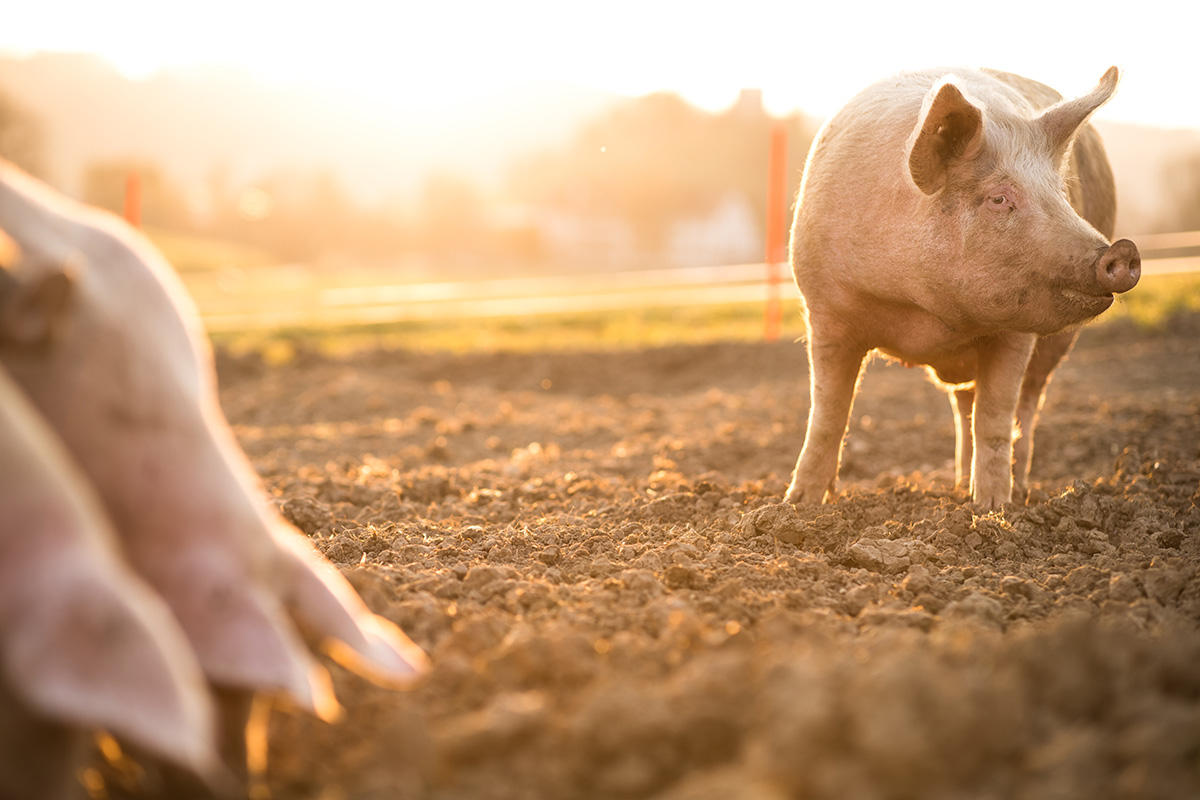12 Sept 2023
Emma Fishbourne highlights recent outbreak issues which are of most concern, and her experience in researching this topic.

Image © allenpaul1000 / Adobe Stock
We have had several exotic disease outbreaks lately in the UK: most recently, the biggest ever avian influenza outbreak (still ongoing) and obviously foot-and-mouth disease (FMD) in 2001 and 2007, bluetongue in 2007-08 and then Schmallenberg virus appeared from nowhere in 2011.
The APHA has just updated (17 July 2023) its contingency plan for exotic notifiable diseases of animals in England. In this plan, the following were highlighted as being of most concern: avian flu and Newcastle disease; FMD; rabies; bluetongue; African swine fever (ASF) and classical swine fever (CSF); African horse sickness (AHS); and lumpy skin disease (LSD).
I have worked on several exotic animal diseases, including FMD, bluetongue, rinderpest, peste des petits ruminants in a research environment, and, as a cattle vet, I unusually opted for a PhD on ASF virus.
In the UK, the then State Veterinary Department was established to tackle a devastating epidemic of cattle plague (rinderpest) in 1865.
Rinderpest is only the second disease to be eradicated from the world after smallpox, but how many vets and farmers are aware of this enormous achievement?
Rinderpest was the first exotic animal disease I worked on while I was an undergraduate. I also dealt with FMD and bluetongue while in private cattle practice in the UK, and I was in the UK cohort who were graduating during the devastating 2001-02 FMD outbreak, so have witnessed the shocking effect on clients and communities of these diseases.
The World Animal Health Information System (WAHIS) is the global animal health reference database of the World Organisation for Animal Health (WOAH). Subscription to WAHIS enables subscribers to receive email animal health alerts (via tinyurl.com/3u89xa6t), enabling users to keep up to date with disease outbreaks bordering the UK and the current global situation. The WOAH website also has useful information on listed and emerging diseases, with details on clinical signs, routes of transmission and links to some of the latest research.
The APHA also provides a subscription service that notifies subscribers when an exotic notifiable animal disease outbreak occurs in Great Britain (tinyurl.com/mrx99h64), and again, the Government website has useful details regarding clinical presentation of some specific notifiable animal diseases. However, as Schmallenberg highlighted, while we can be aware of what might be close to our borders, things can surprise us and come out of apparently nowhere.
Worldwide, one of the biggest threats to human and animal health is arthropod-borne disease transmission (Folly et al, 2020). Across Europe, evidence is growing that distribution of ticks and tick-borne disease transmission is increasing (Johnson et al, 2022).
The UK’s physical separation from mainland Europe does offer a barrier to some of the pathogens that infect animals on the continent, with strict biosecurity rules in place on entry.
However, the increase in movement of people, pets and livestock creates a risk, as they may each bring with them an invasive arthropod species that themselves are infected or are known competent vectors for certain diseases. For example, the movement of companion dogs is thought to be responsible for a cluster of canine babesiosis in southern England in 2016, and we imported 58,000 cattle from Europe in 2013.
A lot of cattle movement has probably been happening due to TB culls and cheaper prices on the continent for replacements, but I would ask if the risk is worth it. Migratory birds also pose a risk; a competent tick vector for Crimean-Congo haemorrhagic fever virus was identified on a horse that had not travelled outside the UK, but was stabled where migrating swallows nested (Johnson et al, 2022).
The risk of tick-borne disease persistence and transmission could also be increased with changes in climate or habitat. Higher temperatures lead to an extended period over which ticks are active, increasing the risk of disease transmission and new diseases. As an example the most common tick species in the British Isles (the common deer or sheep tick – Ixodes ricinus) will seek a host when temperatures are above 7°C for five consecutive days.
In the UK, I ricinus is found in upland grazing areas, as well as lowland grazed grassland and increasingly in urban green spaces, potentially posing a bigger risk to humans and companion animals, as this tick has been reported to feed on more than 160 vertebrates (Johnson et al, 2022).

Mosquitoes that blood feed on avian hosts are important vectors of many arboviruses, such as west Nile virus (WNV), Usutu virus (USUTV) and sindbis virus, which have increased in mainland Europe and could also be introduced through migrating birds (Folly et al, 2020).
Studies in the UK haven’t found active viruses, but have found serological evidence of these viruses, and our farms provide habitat for the development of a wide diversity of mosquitoes (Brugman et al, 2018). In the bluetongue outbreak in 2007-08, we had serotype 8. At the present, 27 serotypes with several different serotypes exist in mainland Europe.
Bluetongue is a viral disease spread by biting midges, which could be introduced into the UK via the wind, as well as being introduced via importation of infected animals.
In France during the last outbreak, other serotypes were present in addition to serotype 8, so the risk of another serotype entering the UK was a very real risk.
I shall focus here on the diseases highlighted in the latest APHA guidelines, and on those that affect cattle, sheep and pigs: FMD, rabies, bluetongue, ASF and CSF, and LSD.
FMD is caused by a virus and will always be up there, as it affects all cloven-hoofed animals, is highly contagious, and has rapid replication and a short incubation period. It is easily spread through fomites, and animals can be infected via respiratory aerosols, with the virus being carried over large distances – particularly over water.
Outbreaks of FMD in the Isle of Wight in the 1980s could be traced to outbreaks in France. Animals can also be carriers, and meat and by-products are also sources of infection.
FMD is endemic in many countries, including those within Africa and Asia. Seven serotypes of FMD virus exist, with serotype O being the most widespread. Within each serotype, genotypes can be geographically restricted (referred to as topotypes).
In 2013, a topotype of O that had usually been found in the Indian sub-continent emerged in North Africa and the Middle East. This was of concern due to the large jump and because vaccines in that area weren’t specific to that strain. Vaccines held in Europe were also targeted towards the strains that were on their borders not this one.
Clinical signs of FMD include pyrexia and vesicular lesions on the coronary band and mucosal surfaces, causing lameness and reluctance to eat due to pain. Typically, large numbers of animals will be affected, with no age predilection.
In sheep, FMD can be more difficult to detect as the lesions are not as obvious as in cattle and pigs.
Rabies presents similarly in our common farm species. In one study where 20 cattle and 5 sheep were challenged with rabies, the average incubation period was 15.1 days and the average morbidity period was 3.7 days in cattle, and in sheep, the average incubation period was 10 days, and the average morbidity period was 3.25 days.
The study reported that the major clinical signs in cattle included excessive salivation (100%); behavioural change (100%); muzzle tremors (80%); vocalisation (bellowing; 70%); aggression, hyperaesthesia and/or hyperexcitability (70%); and pharyngeal paresis/paralysis (60%).
The furious form of rabies was seen in 70% of the cattle. Major clinical signs in sheep included muzzle and/or head tremors (80%); aggressiveness, hyperexcitability and/or hyperaesthesia (80%); trismus (60%); salivation (60%); vocalisation (60%); and recumbency (40%), with the furious form of rabies manifested in 80% of the sheep (Hudson et al, 1996).
Pigs present similarly with facial twitching, rapid chewing, salivation, aggression, muscle spasm and paralysis, with death in around three days.

Bluetongue virus infects all species of ruminant, with severe disease usually found in certain breeds of sheep, with deer and cattle usually acting as reservoirs of infection.
With the bluetongue serotype 8 outbreak, we did see uncharacteristically higher numbers of cattle affected. I had a beef suckler cow confirmed with bluetongue which unfortunately had to be euthanised due to the severity of her symptoms.
Typical clinical signs include pyrexia, excessive salivation, depression, respiratory signs (dyspnoea, panting and nasal discharge), and hyperaemia of the muzzle, lips, face, eyelids and ears, leading to oedema. The tongue can become hyperaemic and oedematous, leading to a “blue tongue”. The hyperaemia can spread to the coronary band of the hoof, causing coronitis and lameness. You may also see ulceration of the oral mucosa.
ASF virus has never been identified in the UK and, until 2008, it was confined mainly to sub–Saharan Africa, but an outbreak then started in the Black Sea port of Poti. The disease has since spread and its prevalence across Europe is increasing. The virus can have 100% mortality in domestic pigs; in the early stages pigs present with pyrexia, inappetence, and then may show gastrointestinal signs and skin discolouration. Death typically occurs within a few days after infection.
Contact with infected pigs is the most common source of infection, but ASF virus is highly resistant and can persist in infected tissues and even processed or frozen meat, so its introduction to the UK through human food is a genuine risk.
An online questionnaire aimed at pet and smallholder pig owners in England highlighted a lack of knowledge of the legislation regarding registration, animal movements and feeding of domestic waste, with 23.9% of those who answered feeding household scraps to their pigs, posing a potential risk for the incursion and spread of infectious diseases such as FMD, ASF and CSF (Gillespie et al, 2015). ASF is considered the most significant exotic disease risk to the UK pig sector.
CSF or hog cholera can present very similarly to ASF; however, less virulent strains exist that can present with very vague clinical signs, with the only sign being poor reproductive performance and the birth of piglets with neurological signs. Both ASF and CSF can be spread by fomites.
LSD has traditionally been found in southern Africa, but it has recently been spreading northwards and has been found in eastern Europe and Russia.
LSD is caused by a virus that affects cattle and buffalo. The main route of transmission is thought to be by biting vectors such as flies and mosquitoes, but direct animal-to-animal transmission is also thought to occur. Clinically affected animals present with pyrexia, inappetence, ocular and nasal discharge and nodules all over the body, which can develop internally.
Younger animals tend to be more severely affected and mortality rates can reach 10%.
Tight biosecurity and responsible sourcing of livestock and feed are central to maintaining freedom from the mentioned diseases.
We need to educate our clients about the potential risks and highlight the importance of contacting us if they suspect something out of the ordinary, if multiple age groups are affected, or if their usual treatment hasn’t worked.
A legal duty is placed on any person who suspects that an animal may have a notifiable disease to report it to the APHA.
In England, use the Defra rural services helpline on 03000 200 301, which is open 24/7; in Scotland, contact the field service local office at APHA (tinyurl.com/nb5aywxc); in Wales, telephone 0300 303 8268.